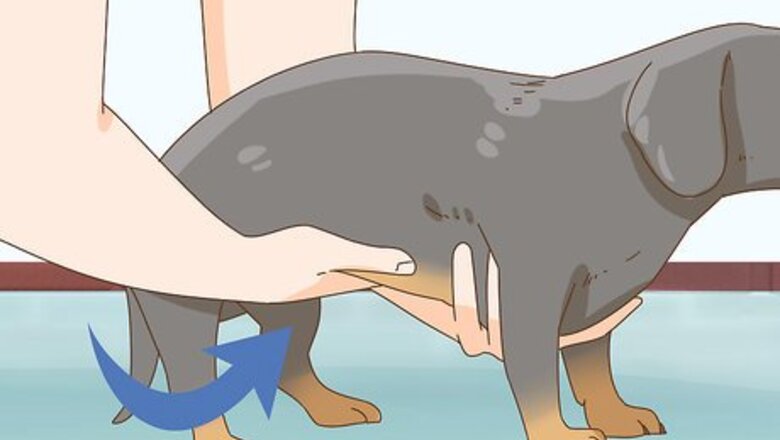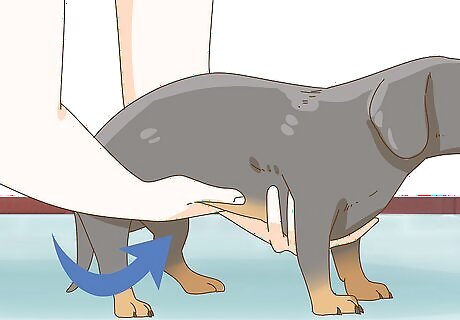
views
Holding a Dachshund Safely
Place one hand under the chest. Picking up a dachshund is different than the way you'd pick up other breeds, but it's not especially hard once you learn the right method. Start by slipping a hand under the dog's upper body to support his chest and ribcage. Don't lift up yet. Spread your fingers out so that you support as much of the dog's upper body as possible. The wider the area you can spread his weight over, the gentler it will be on his spine. Make sure that the dachshund knows that you're picking them up first! A lot of dogs get nervous because they're walking and then suddenly scooped up into the air.

Place your other hand under the dog's rump. Gently slip your free hand under the dog's rump — either directly behind it or just in front of the dog's rear legs to support its lower body. Get ready to lift up. Here, again, it is best to spread your hand to give the widest base of support possible. Since dachshunds have an elongated spine and back, they're more likely to have back and spinal issues. So, you always want to make sure that you're supporting their lower back whenever you hold them.
Slowly lift the dachshund, keeping his body level. Now, simply lift the dog up. As you go, try to keep the dog's lower body from hanging or drooping beneath his lower body. A little bending is fine, but you'll want to keep the dog's back as flat as possible to keep from putting stress on it.
Continue to support the dog's back as you hold it. As you move around or play with your dachshund, make sure his lower back is well-supported at all times. Dachshunds aren't like other dogs — letting their lower bodies dangle is uncomfortable to them and can contribute to painful back problems (like slipped and ruptured discs) over time. Luckily, with a little practice, this should become second nature after a while. Eventually, it will feel "wrong" to pick the dachshund up in the incorrect way.
Transition to a "cradle" hold if you wish. As long as the dachshund's back is well-supported and his body is fairly straight, it doesn't really matter how you choose to hold him. If you'd like the convenience of being able to hold your dachshund with one arm, try shifting to this alternate hold once you've picked him up correctly by following the steps above: Gently shift the dog's weight so that it comes to rest on the forearm of the arm that you were using to support his rump. Use your full forearm to support his weight. Tuck the dog against your body for added support and comfort. This should feel a little like how you would cradle a baby or hold a football. Use your free arm when needed to help the dog balance and keep him from squirming or wriggling free.
To set the dachshund down, slowly lower him to the floor. If you've had experience with other dog breeds, you may be used to "dropping" or gently heaving them back to the ground when you're done holding them. With dachshunds, instead, you'll want to lower the dog all the way to the ground before letting go. As always, keep his back well-supported as you lower him down. Ideally, you'll want his feet to be touching the ground before you let go. As you'll read below, even a drop of a few inches can put stress on the dachshund's back and joints. Always make sure that you're placing the pup on a solid surface.
Knowing What to Avoid
Don't pick up a dachshund by his upper body. Many are accustomed to picking up dogs as if they were human babies by putting one hand under each of the dog's "armpits." However, this is unsafe for dachshunds. This puts an unnatural stress on the dog's back — the spine simply isn't built to support his long body without any other support. In general, you will want to avoid any sort of hold that supports only half of the dog's body length. This is true even if the dog is already standing on one set of legs — like, for instance, if he is propping himself up on his hind legs while looking over the top of a sofa. In this case, you'll want to lean down so that you can support his rump before picking him up.
Never drop the dachshund back onto the ground. As noted above, dogs should be set down gently, not dropped. A dachshund's legs are very short compared to other dog breeds'. This means that they can't bend very far to absorb the shock of hitting the ground, which puts most of the impact stress on the leg joints and back. Getting rid of the dog's "fall" eliminates this danger. Don't trust your dog's body language here. Dachshunds don't know that their skeleton can't support falls, so they may be perfectly willing to jump out of your hands. Even if this doesn't cause them immediate pain, it can lead to painful problems if continued in the long-term.
Never make a dachshund bend or twist when you pick him up. Dachshunds' long, slender spines are especially vulnerable to injury, which is why it's so important to keep their bodies straight when you pick them up. You will definitely want to avoid any activities that put a twist or bend in the dog's back, as this increases the stress on it and can contribute to conditions like slipped discs. For example, one way you might accidentally do this is by scooping the dachshund up suddenly when he doesn't expect it. If you startle your dog, he may wriggle or twist out of one of your hands, putting an unnatural bend in his spine as he hangs. Make sure your dog is calm and aware of you before you attempt to pick him up.
Don't ignore any signs of distress from the dog. Dachshunds, like all dogs, are generally pretty smart about letting you know when they are in pain. If your dog looks or sounds uncomfortable when you pick him up, he probably is, so set him back down and re-evaluate the way you're holding him before you try again. Some signs of pain in dogs are obvious, like yelping, whimpering, etc. However, others a little more subtle. The following are nonverbal signs that a dog may be uncomfortable: Trembling (without another explanation, like coldness) Trying to get away Unnatural amounts of affection or aggression Holding the mouth closed (rather than having a natural, "happy" look)
Show family and friends how to hold dachshunds properly before letting them play. Nothing's more frustrating than when you take the time to learn how to hold your dachshund properly, only for well-meaning relatives to come over and treat him like an ordinary dog. To avoid problems, be sure to educate any visitors about the proper ways to hold your dog before they play with him. This is especially true for children, who can sometimes be too rough with dogs by accident. It's a wise idea to supervise children when they first interact with your dachshund until you're confident that they know how to play safely.




















Comments
0 comment